|
|
The Bard

|
|
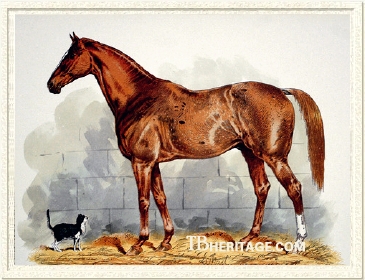 |
|
|
A small colt with a game heart, The Bard, unbeaten in his sixteen juvenile races, won all but two of his twenty-five starts, at distances from five furlongs to 2-1/4 miles. He was a member of the great generation that included Ormonde, Minting, and Saraband, that made for some of the best racing England ever saw. As a stallion in France he got eight classic winners and led the sires list there twice. He did not get a sire son to continue his line among thoroughbreds, although several had an influence on half-bred breeding in France. He is seen in thoroughbred pedigrees today through his daughters.
His sire, Petrarch (1873, by Doncaster St. Leger winner Lord Clifden), was a well-bred horse that took the Two Thousand Guineas, Doncaster St. Leger and Ascot Gold Cup, among other races. A beautiful animal plagued with kidney problems that hampered his racing career, he won eight of his sixteen starts in three seasons on the turf. At stud at Hampton Court and Newmarket, Petrarch was a popular stallion, frequently near the top of the leading sires lists, turning out precocious juvenile winners year after year, and three fillies that won five classic races between them. His daughter Busybody, who won both the One Thousand Guineas and the Oaks, would become the dam of Meddler, a two-time leading sire in the U.S., and other Petrarch fillies became the dams of important matrons. Petrarch's son Hackler, a poor racehorse, became a leading sire of flat runners in Ireland and a superior and multiple-times leading sire of steeplechasers in Ireland and Great Britain. The Bard, however, was Petrarch's best son, both on the turf and in the breeding shed.
The Bard's dam, Magdalene, was bred in Yorkshire by Maj. Myles Stapylton, who purchased her in-foal dam, My Mary (1859, by the Harkaway son Idle Boy) in 1868, and bred eight more foals from her, most minor winners, before Magdalene was born in 1877. My Mary had been a tough, sturdy miler for her breeder, T.W. Redhead, that at age two won Liverpool's Knowsley Handicap (beating twelve) in seven starts, with two second placings. At age three My Mary was her sire's best runner, winning eight of her 19 starts, and placing second or third six times, over usually big fields and almost always carrying the highest weights. Her wins included Carlisle's Corby Castle Stakes, Warwick's Grand Stand Plate (3/4 mile, by 3 lengths, nine runners), Doncaster's Corporation Plate (13 ran), and Kelso's Border Handicap, one mile). She ran through age five, when she took the one mile Hambleton Purse at Northampton (one mile, beating eleven) and Chester's Wynnstay Handicap (one mile, beating eight).
Magdalene was by Syrian (1867), a son of Mentmore (by Melbourne). Syrian was a long-running "tough customer" for Stapylton, whose big wins came later in his career, taking the Newport Cup at Shrewsbury in 1872 and the Great Shropshire Handicap in both 1873 and 1874.
Magdalene was a high-strung chestnut filly that ran nine times as a juvenile, and won the Two Year Old Selling Stakes at Newmarket Second Spring for Dudley Milner, who purchased her as a yearling. That season she also placed second three times in fairly good fields, to Lector in the New Nursery Stakes at Newmarket Houghton, to Cylinder by a neck in the Liverpool Autumn Nursery Stakes (6 furlongs, six ran), and to Moonstone by a neck in Derby's five furlong Chesterfield Nursery, with eleven runners. She last ran at age four, where she was fourth in her only start, Epsom's Great Surrey Handicap (five furlongs), giving weight to the first three finishers. She was sold as a broodmare to Lord Wolverton, and entered his stud at his seat, Iwerne Minster, at Blandford in Dorset. The baron, an "ardent" sportsman particularly fond of hunting, was a principal in a London banking house, and bred horses, cattle, game birds and other creatures at his seat. He did not race his thoroughbreds, but sold them as yearlings at Newmarket. Magdalene bred only three foals for Lord Wolverton before she was injured in an accident in 1885 and was destroyed.
The Bard's half-sister, Mrs. Bardwell (1884, by See-Saw) produced two fillies, both sent abroad, that were successful broodmares -- Highland Queen (1889, by Highland Chief) went to Germany, where she produced Hamilkar (1899, by Hannibal) and Hildegard (1904, by Sperber's Bruder), both Deutsches St. Leger winners. Mrs. Bardwell's daughter Maranine (1895, by Florestan), sold to Italy, produced Gran Premio di Milano winner Massena (1903, by Melanion).
The Bard, born in 1883, was a small chestnut colt with a blaze and a white hind sock, and when grown, barely reached 15 hands. But, taking after his sire in looks, if not in size, he was "...a perfect beauty -- a pocket Hercules, well worthy to overtake in looks with the best of them..." the "them meaning the dead-and-gone heroes of thirty, forty, and fifty years ago." His chestnut coat was flecked with white hairs to the extent that he was frequently referred to as a roan. "No better legs and feet were ever seen; his legs like bars of iron...altogether truly-shaped" with "action beautifully true."
The Bard was sent to the Newmarket July sales in 1884, where he was purchased by trainer Robert Peck (see Saraband), who would also buy his half-sister, Mrs. Bardwell (first called Unity), a year later. Peck sold a half-interest in The Bard to a client, General Owen Williams. Williams became a member of the Jockey Club in 1881, and dabbled in a minor way in thoroughbred breeding at his stud at Temple Park, Great Marlow, Berkshire. Williams, of an ancient Welsh family, served in India as a young man, and later became a M.P. for Berkshire. He was a close friend of the Prince of Wales, and was drawn into that sporting circle. Peck had other promising colts in his stable, and to avoid conflict of interest, The Bard was handed over to his head lad, Martin Gurry, to train at Park Lodge at Newmarket.
The Bard on the Turf
The Bard was one of four superior horses -- and a number of additional good ones -- that made racing in 1885 and 1886 two of the best years in the annals of the English turf. The other three were the great triple crown winner, Ormonde, and Minting and Saraband, the latter two plagued by injuries; Saraband was in Peck's care as trainer, and, at least publicly, he gave the impression that he thought Saraband a better horse than The Bard. Whenever The Bard, Minting, or Saraband, are mentioned in turf histories, their accomplishments are always tempered by the phrase, "he had the misfortune to be born in the same year as Ormonde, otherwise..."
The Bard started 25 times, and won 23, placing second twice, in two seasons. Over half his wins were as a juvenile, when he went unbeaten in his sixteen starts -- a record at the time -- and earning £9,188. The little colt was speedy, but could easily get two miles, and every description of him mentions how game he was: "His eye and whole demeanor bespeak the courage of a lion and the dash of a true race-horse..." Some turf commentators stated he was lucky to win as he had as a juvenile, and some noted that he seldom met any horses of quality. But Peck and Gurry were canny in their selection of The Bard's races, and while skirting any juvenile meeting with the other future powerhouses -- Minting, Ormonde, and Saraband --The Bard still had some good races against worthy opponents at age two, and in most of his contests he was giving them a lot of weight.
The Bard debuted at Lincoln in the Brocklesby Stakes in March. He won easily by two lengths, beating fifteen other youngsters. Next up was Liverpool's Molyneux Stakes, which he took by three lengths, beating eight. At Northampton he took the five furlong Althorp Park Stakes, four lengths ahead of four others, and the next day won the Ascot Plate (five furlongs) by a neck, with six in the field. At Epsom he easily took the Westminster Stakes (five furlongs) by a half-length and the Hyde Park Plate (five furlongs) by 3/4 of a length, beating four. Next was the Sandown Stakes (five furlongs) at Sandown Park, won by 3/4 of a length, with five in the field. At Newmarket he won the Spring Two Year Old Stakes by a length, with three others running. At Windsor he beat four in the St. George's Plate (five furlongs). At Manchester's spring meet he took the Hartington Plate by a half length, beating two, and the John O'Gaunt Plate (six furlongs). At Ascot he ran in the Biennial, which he won in a "common canter" by six lengths, beating three, including two three-year-olds. At Liverpool spring he took a walk-over for the Mersey Stakes. At Manchester summer he won the July Plate (six furlongs) by three lengths, beating Alaric and one other. At Sandown he took the Great Kingsley Stkaes by 3/4 of a length, with four others in the field. His last race of the season was at Doncaster, where he won the Tattersall's Sales Stakes by three lengths, beating three.
He had covered a lot of territory over most of England in his young life, and had avoided meeting any of the other high-class juveniles of his generation, including Saraband, who was trained by his owner. He was put away for the year before the big fall races for juveniles, which were dominated by Minting and Ormonde. Although the odds shifted frequently during 1885, by the end of the season -- The Bard hadn't been seen since August -- the betting for the Derby of '86 favored Ormonde, with Minting second, Saraband third, and The Bard fourth. As it turned out, Saraband wasn't sound enough to run in the Derby, and Minting's owner, for various reasons -- including Ormonde, who had easily beaten Minting in the Two Thousand Guineas -- was taken to France to run in and win the Grand Prix de Paris.
The Bard's first race at three, and first defeat, was the 1886 Epsom Derby. After the start, he passed horse after horse, and headed Ormonde to take the lead in the straight, and it appeared, briefly, that he would triumph, but Ormonde, hanging at his flank, responded to jockey Fred Archer's urging, and lengthened his great stride. There was no way the game little chestnut could match that stride, regardless of the whip applied by his jockey, Charles Wood, and Ormonde surged ahead to beat The Bard into second place by a 1-1/2 lengths. "The last hundred yards," said a turf writer, "was a treat to see...Both horses ran straight as a die, the little Bard displaying unflinching gameness where he had the worst of the race, but he could not stride with the bigger opponent Ormonde." "Ormonde," said another writer, "won the race cleverly, but not easily." After the race Williams and The Bard were seen in the enclosure in front of the weighing room..."The beautiful colt rubbed his nose affectionately against his master, who responded by stroking the creature's soft muzzle. It was a charming picture."
His next race was the Manchester Cup at Newmarket July (1-3/4 miles), with ten in the field. In this race The Bard was weighted with 8 st-4 lbs., by far the heaviest load. He ran second to the inferior and lightly-weighted Riversdale, carrying 6 st.-11 lbs., his second -- and last -- defeat. After that, he went to Liverpool July, winning the 1-1/2 mile St. George's Stakes, beating his only other opponent, Sir Isaac, in a canter. At Goodwood, for the first time in sixty years, there were no challengers for the Cup, and The Bard took a walk-over, and followed that up by winning the one mile Singleton Plate, beating Whitefriar by ten lengths. At Lewes, no one came to the post to challenge him for the two mile Queen's Plate, and he took a walk-over. At York August he won the two mile Queen's Plate by three lengths, beating four others. He was not nominated for the Doncaster St. Leger (won by Ormonde), but ran in the Doncaster Cup, which he took without difficulty, beating three others. An agreement was reached between the various owners of Ormonde, Melton and The Bard for a special match race at £1,000 each at Newmarket in the fall, and The Bard was scheduled to run in the Cesarewitch at Newmarket in October. Peck and Williams scratached The Bard from the Cesarewitch when he was handicapped with ten extra pounds against a good field, which they believed to be unfair to the horse. Both Melton and The Bard forfeited for the Private Match, so Ormonde picked up that money.
That fall Peck and Williams could not pass up the £10,000 offered to them for The Bard by French sugar magnat Henri Say, and early in 1887 The Bard went to Say's elaborate Haras de Larmoy (complete with race track) at Longpont Saint Michel, near Paris, in France. Of course, no one knew then that Ormonde would have trouble settling his mares and would soon be off to Argentina, that Saraband's moderate success at stud in England would send him to Germany (where he was a multiple-times leading sire), or that Minting would be virtually useless as a stallion. Perhaps The Bard, despite his somewhat weak female line, would have been a great stallion in England. As it came to pass, he was twice leading sire in France.
The Bard in the Stud
Between 1891, when his first crop were three-year-olds, and 1902, when his last crop hit the ground, The Bard got eight classic winners in France, and was twice leading sire, in 1894 and 1901, and near the top in the years in-between. His classic winners included BÉRENGER (1888) and GOUVERNAIL (1891), both winners of the Prix Royal Oak; SAXON (1898), who took the Prix du Jockey Club; ANNITA (1889), a winner of the Prix de Diane; TILLY (1890) and CALCÉOLAIRE (1891), both winners of the Poule d'Essai des Pouliches, and LAUNAY(1892) and INDIAN CHIEF (1894), both of which won the Poule d'Essai des Poulains. Most of his youngsters could win at classic distances, and there were several high-class stayers amongst them. Few were as speedy over short distances as he was, but could call upon speed to win over longer distances.
Most of The Bard's offspring were bred and raced by Henri Say, until Say died in 1899, and by Edmond Blanc, a prominent French breeder. Say's colts and fillies by The Bard were sent to Richard Carter, a public trainer at Chantilly, who had schooled many of count Fréderíc de Langrange's horses. Say's widow opted to continue the breeding stud at Lormay, but liquidated the racing stable after her husband's death, selling 25 runners and 20 yearlings for a total of 780,000 francs. The Bard's son, MAGISTRAL (1896, out of Maggie, by Wellingtonia) was the sales topper, purchased by Carter for 55,000 francs. After that, for the few years left until his death in 1902, The Bard's youngsters bred at Larmoy were sold for good prices at the yearling sales.
As far as The Bard's sons were concerned, after their racing careers a number were sold to the Haras Nationaux, where they were used as improvement sires on half-breds. Several of his sons are seen, through sons and daughters, as stallions in Anglo-Arab, Selle Française, and Demi-Sang (AQPS) pedigrees, in all three Olympic equestrian disciplines. He is seen in thoroughbred pedigrees today through his daughters.
The Bard's first good runner was BÉRENGER (1888, out of Boutade, by Trocadero), a stayer. The chestnut colt won the Prix Royal Oak at age three, but came into his own at age four, when he took the Prix des Sablons (2400 meters), Prix du Cadran (4200 meters), Prix Rainbow (5000 meters), and Prix La Rochette, and was indisputably the best of the aged horses in France that year. He got some winners as a stallion, notably the filly Le Senateur (1895), who, at age four in England, failed to place in the Ascot Gold Cup, won by her stablemate Gardefeu, but took the two mile Queen Alexandra Stakes a few days later. Several of his thoroughbred daughters bred on. In 1899 BÉRENGER was sold to the state stud for 7,000 guineas, and stood at a "station" -- a private stud where mares in the surrounding area could breed for free -- the Haras du Pas Vienne.
Another useful colt of 1888 was THE MINSTREL (from Malibran by Consul), a winner of the Grand Prix de Bruxelles. His daughter Carabine (1902, from Margate) went to Argentina, where she established a family of good stakes winners.
The 1889 crop included ANNITA, MADCAP, and ST. MICHEL. ANNITA (1889, from Lina, by Monarque) was The Bard's second classic winner. Bred and raced by Say, and out of a half-sister to classic winners Zut, Clementine, and Ascot Gold Cup winner Verneuil, she took the Prix de Diane, after placing second to Kairouan in the Prix d'Essai des Pouliches, and also won the Prix Bagatelle. She later produced All Mine, a filly that won the Prix de Flore at Saint Cloud.
MADCAP (1889, a brother to THE MINSTREL), was bred by Say and for him won the Prix des Cars at age three. ST. MICHEL (1889, out of Sainte Cecilia, by Hermit), took the Prix Lagrange (2,000 meters) and the Prix du Nabob (Prix Noialles, 2,500 meters) at age three.
MADCAP got Lieutel (1905), whose wins included the Prix Hocquart at age three, and the Prix Boiard at age five, and several other more modest winners, including Dor (1906), a winner of eight races, including the Prix de Gallion, the Prix de l'Escaut, the Grand Prix de Vichy, and the Prix de Blois. MADCAP'S daughter Hasseki (1896) was a good broodmare that produced Haki (1912), a grand stayer that in England won the Ascot Stakes, Doncaster Cup and Queen Alexandra Stakes, and Halima (1905) and Habana (1913), both of which bred on with stakes-winning descendants. ST. MICHEL was one of The Bard sons that was sold to the national stud.
The star of the 1890 crop was TILLY (out of Regine, by Mortemer), a winner of the Poule d'Essai des Pouliches, and The Bard's third classic winner. She was closely related to ANNITA in tail-female. TILLY did not establish a good female line, but her sister, THE SHREW (1894), did, with stakes winners in France extending into the twentieth century.
The Bard's 1891 crop included two more classic winners, CALCÉOLAIRE (1891, from imported Ella, by Exminster), and GOUVERNAIL (1891, out of Gladia, by Tournament), the latter bred by Edmond Blanc. Their wins, along with those of several others, put The Bard at the top of the sires list in 1894.
|
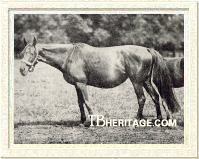
Calcéolaire
| |
CALCÉOLAIRE had been purchased at Edmond Blanc's dispersal sale as a yearling by A. Abeille for 15,500 francs, one of the sales-toppers. For Abeille she won the Poule d'Essai des Pouliches, was half a length behind Brisk, a much inferior filly, in the Prix de Diane, and took the Handicap Limité at the end of the season. A lovely chestnut with excellent legs and feet, she became the dam of the good race filly Orange Blossom (1901, Prix Lagrange, Prix Morny), and of Medeola (1899), whose tail-female descendants included the fine Perth filly Sauge Pourprée (1905), and, a hundred years later, dual English classic winner Midway Lady (1983). Another The Bard filly from 1891, Edmond Blanc's FLORIDE, won the Prix de Lonray and was second in the Poule d'Essai des Pouliches to CALCÉOLAIRE.
|
The Bard's daughter CAMPANULE (1891, out of Santa Lucia, by Rosicrucian), also a member of the 1891 crop, was his most significant broodmare daughter. She produced Codoman (1897, by Cambyse), an excellent mid-distance runner over three seasons in France, whose wins included the Prix du Conseil Municipal, Prix Boiard, Prix Biennal, and numerous other races. She was also the dam of Chouberski (1902, by Gardefeu), a winner of just one race with an abbreviated stud career -- but he got the dual-classic winner Brûleur (1910) and some other good winners, and Brûleur was a significant stallion that led the French sires list three times.
|
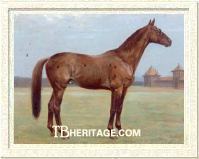
Gouvernail
| |
GOUVERNAIL, bred and raced by Edmond Blanc, had his sire's grey-ticked coat, but was not the runner The Bard had been, despite his high-class dam, Gladia, who also produced the good juvenile Gouverneur (1888, Newmarket's Criterion Stakes and Middle Park Stakes, also good races in France at age three, later a leading sire in Germany) and Gouvernante, the dam of two French classic winners. Still, he did well enough, with wins at age three including the Grande Poule des Produits (Prix Lupin) and the Prix Royal Oak, making him another classic winner for The Bard. In England he ran second to Isinglass in Newmarket's Jockey Club Stakes. He first stood at Haras de Pouzac at Bagnères, he was sold at age seven to the Haras Nationaux, and stood at Bessin under the administration of St. Lô, and got just a few thoroughbred offspring. His daughter Saphire was second dam of the Anglo-Arab stallion Salteador II. |
The best of the 1892 crop was LAUNAY (1892, from Lina by Monarque, and so brother to ANNITA). His principal win was the Poule d'Essai des Poulains, adding to the number of classic winners by his sire. Always a contender, he also was barely beaten into second in the Prix Lagrange (2,000 meters) by Merlin, and ran second to that horse in several other good races, including the Prix des Sablons at age four. At age five he won the Prix de Bois Roussel. He was later a useful stallion, sire of Princesse Lointaine (1902), a winner of the Poule d'Essai des Pouliches, and of Rab Joie (1904), a stayer that won the Prix Gladiateur. Several of his daughters bred on.
INDIAN CHIEF (1894, out of Indian Summer, by Uncas), bred and raced by Say, was a winning juvenile that took Deauville's Prix de Deux Ans (Prix Morny) and went on to take the Poule d'Essai des Poulains, the Prix Morny, and the Biennal de Maisons-Laffitte, placing second to Palmiste (the best of their generation) in the Prix Lupin. His younger sister, INDIAN SHORE (1898), was also a good juvenile that won the Deuxième Critérium at Longchamp. INDIAN SHORE'S tail-female line continued through the twentieth century. Another The Bard colt from 1894, VIDAME (from Viadana by Beaudesert) won the Omnium as a juvenile, and at age three the Prix Monarque (2,000 meters) at Maisons-Laffitte for Henri Say. LONGBOW (1894, out of Old Bow, by Beauclerc), a very modest winner of 12,425 francs, was one of the sons that was sold (for 20,000 francs) to the Haras Nationaux.
|
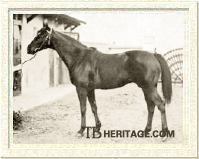
Thibet
| |
The 1896 crop included MAGISTRAL, purchased by Maurice Ephrussi as a yearling, for whom he won the Prix de Victot and Prix Le Sancy at age three, and the Prix de Bois Roussel at age four. Another son, THIBET (brother to TIBÈRE), purchased at the Say dispersal sale of 1899, was a minor winner of 77,000 francs. He eventually became a national stud stallion; he got Titus, an Anglo-Arab stallion that had some influence in Swiss warmblood breeding. |
Two important The Bard daughters were also born in 1896: MAGDALA (from Malibran, by Consul, and so sister to THE MINSTREL and MADCAP), and BAYREUTH (out of Alveole, by Crafton). MAGDALA produced two classic winners: Mordant (1904, by War Dance, Prix du Jockey Club), and the in-bred Monitor (1905, by Codoman, Poule d'Essai des Poulains). Her female line continued through the twentieth century, as did that of her sister's, MATHILDE (1900), dam of Prix de Diane and Prix Vermeille winner Moia (1910, by MacDonald).
Alveole (1889), a mare by Crafton, was sold in foal to The Bard to Georg von Bleichröder and installed at his Gestüt Römerhof in Germany, where in 1896 she dropped BAYREUTH, followed by Fama (1900, by Saraband), Antwort (1907, by Ard Patrick), and other good ones that extended Alveole's female line and made her one of Germany's premier matrons.
BAYREUTH won the Fridrich Franz-Rennen at age three, but her value was in the breeding shed, where she produced two superior fillies, Habemus (1902, by Saraband) and Ibidem (1903, by Little Duck). Habemus won the Criterium at Hamburg and the Leipziger Stiftungs-Preis as a juvenile, and established a female line. Ibidem took the Oktober-Preis for Two Year Olds at Frankfurt. At age three she ran third to Fels and Ignis in the Henckel-Rennen (Two Thousand Guineas), but easily took the Preis der Diana, and then ran third to Festino in the Silberner Schild, and third to him again in the Großer Hansa-Preis and to Fels in the Preis von Schlesian at Breslau. Even though Ibidem only placed in those races, she was running against the colts, beaten by two of Germany's great racehorses, Fels and Festino, and was indisputably the top filly of her year. It is from Ibidem that Alveole's family gains most of its luster, with numerous German classic winners, including Ibidem's own Ard Patrick son, Ariel (Deutsches Derby, Grosser Hansa Preis, Union-Rennen).
The Bard colts born in 1897 included MONSIEUR AMÉDÉE (out of My Mary, by Ayrshire) and ROYAL (brother to TILLY). ROYAL won the Prix du Nabob (Prix Noailles) for the Duc de Gramont in 1900. MONSIEUR AMÉDÉE, who was purchased at the Say liquidation in 1899 by Maurice Ephrussi, won six races at age three, including the Grand Prix de Deauville, and the Prix National (2400 meters at Maisons-Laffitte). As winner of the latter race, sponsored by the Societé Sportive, worth 60,000 francs, he was sold for an additional 40,000 francs to the state stud, part of the terms of entry to help develop the national breeding program. He ran one more year, placing in some races at Baden-Baden. He is seen through some daughters in Anglo-Arab pedigrees.
The 1898 crop made The Bard leading sire for the second time in 1901, with earnings of £28,000. SAXON (from imported Shrine, by Isonomy) and TIBÈRE (out of Thebaide by Cambyse) were the principal contributors. TIBÈRE, raced by Maurice Caillault won the Prix du Nabob (Prix Noialles) and Prix Lupin, was third to SAXON in the Prix du Jockey Club, and second to his stablemate, Cheri, in the Grand Prix de Paris. His lasting contribution was to sporthorses; his half-bred daughter, Meurthe (1924) produced Maroc, an Anglo-Arabian stallion that got a top show jumper, Nonchalante (1957), and numerous daughters seen in Selle Française breeding.
|
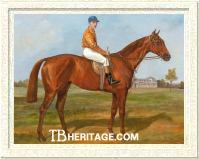
Saxon
| |
SAXON ran for Edmond Blanc. He was third in the Prix de Deux Ans at Longchamp, his only start as a juvenile. At three, after a rocky start, where he was third in the Prix Langrange to two modest horses, and then tossed his jockey in the Prix Noailles, he won four races in a row: the Prix Godolphin, the Prix Daru, the Prix Lupin (beating the great La Camargo by a nose), and the Prix du Jockey Club. He did not place in the Grand Prix de Paris, but came out for the Prix de Longchamp (Prix Kergolay) at Deauville, which he won, after which he was retired from the turf. He got a few runners in France before he was sold to Russia in 1910. |
Other The Bard winners in 1901 included NEFLIER (1898), a winner of the Prix Le Roi Soleil at Saint-Cloud, and INDIAN SHORE, a juvenie winner.
In March of 1902 The Bard was suddenly taken ill at Haras Lormoy, and in great agony, was put down; a post-mortem revealed a twisted gut. Of his remaining crops, the only notable horse was MONSIEUR CHARVET (1901, from Mlle. Chiffon, by Clover), a winner of the Prix Greffulhe at age three. He was another The Bard colt sold to the Haras Nationaux. TARQUIN (1901, brother to TIBÈRE and THIBET) was a modest winner at age four of the Prix de Villarmais and the Prix de Pet; he got a good runner in Matchless, but not much else.
It should be noted that another good horse, also named The Bard, was born in the same year as Petrarch's son, The Bard. This horse, a son of Longfellow, was born and raced in America, and was the leading racehorse there at ages three, four and five; he was, like the English The Bard, speedy, a good stayer, and an excellent weight-carrier. The spare, plain son of Longfellow got a champion racing son, but most of his progeny won at selling and allowance levels.
--Patricia Erigero
|
|
|
|

